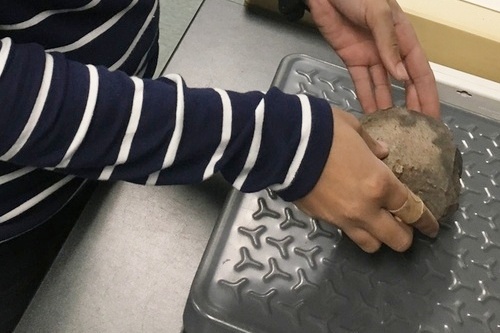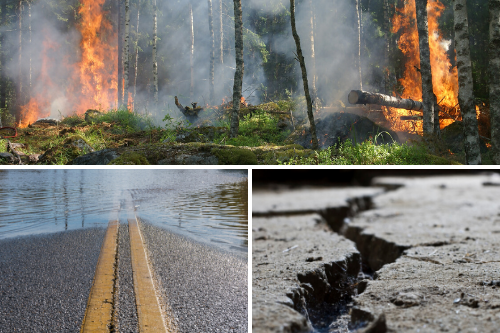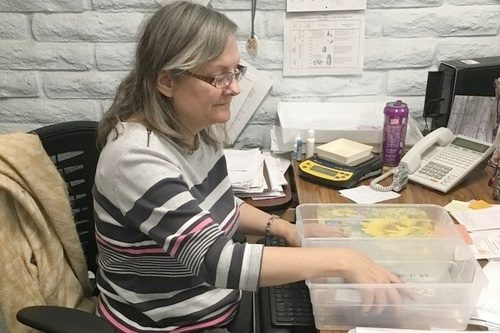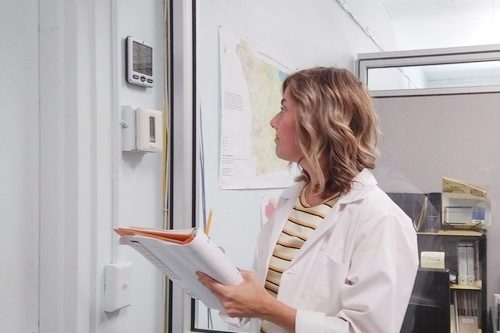
From Inside the Vaults: Artifact Handling
From Inside the Vaults is a monthly blog that gives insight into best practices for collections stewardship, curation, and archaeological collecting institutions.
We have been learning about different best practices used by Collections Managers to protect and preserve museum artifacts and collections. This may be surprising, but harm done to museum collections by humans is much more common than one might think. An incredibly important role of a Collections Manager is to use proper care when handling artifacts and additionally, train and monitor whoever may handle artifacts so that best practices are followed and damage is minimized.
Who Should Handle Artifacts?
Ideally, artifacts should only be handled when absolutely necessary. Less interaction with humans lowers their risk of being damaged. Generally the Collections Manager makes decisions about who may access and handle collections. Some institutions may not allow volunteers or interns to handle artifacts due to a lack of formal training, but many provide training to volunteers, interns, researchers using collections, and non-collections staff.
The San Diego Archaeological Center relies on the assistance from volunteers and interns to assist in the curation of incoming collections. The curation process includes activities such as weighing artifacts, counting quantities, and replacing artifact bags or rehousing things as needed. These tasks all involve artifact handling. By using proper techniques, common sense, and thoughtfulness, collections may be handled appropriately so that damage is not done to the artifacts. When researchers come to the SDAC to access collections, first they must sign a Center Access form (which states responsibilities of the researcher and curation lab rules while near artifacts) and additionally, the best way to handle the artifacts is explained.
Rules for Artifact Handling
While artifact types vary by institution (they even vary within a single collection) general rules can be followed to ensure the safety of the artifacts. The first step before handling any artifact is to make a plan. Where will you lift the artifact from? Where will you set the artifact down? If the artifact is moving, do you have a cart prepared and have you secured the best and safest route to your destination? By having these questions answered before even touching the artifact, you have already reduced the chance for damage to occur. Once you have a plan, make sure the area where you are handling artifacts is clean from harmful substances. There should never be liquids or food near artifacts. Make sure that pens and other writing utensils that could stain are put away and use a pencil if documentation is needed. Most collections require the use of gloves when handling artifacts. At the SDAC, we use nitrile gloves (as many people are allergic to latex) but when working with archaeological collections – gloves are not always required depending upon the material class. One reason to wear gloves is to protect the artifact from oils and debris that may be on your skin, but also wearing gloves is important for your protection. In the past I worked with natural history specimens that had previously been treated with arsenic. By wearing gloves when I handled the artifacts, I created a barrier between me and this powerful, dangerous chemical. Make sure to wash hands before artifact handling, especially if you are not wearing gloves – but even if you are wearing them, your hands should be clean. Wearing an apron or lab coat may also help reduce the transfer of dirt and debris from/to the artifact. Remove jewelry and other things that you are wearing that could potentially damage artifacts. For example, a bracelet may scratch an artifact if it rubs against it while you are handling it.
Transporting Artifacts
Now that you have a plan and your workspace (and you) are clean: it is time to examine the artifact. Are there any areas that seem damaged already? Are there weak spots? Where would be the best place to hold the artifact? By gently touching and examining the artifact, you can gain useful knowledge about its condition that will help you as you handle it. Start by examining the base, this is the area that you generally will support/hold the artifact from if it is secure enough. If the base is compromised, find the strongest part of the artifact and begin to examine this area. Only one artifact should be carried at a time, and if applicable, artifacts should be transported by cart. (This is not always possible dependent on budget, collections location, etc.) Once on the cart, make sure that the artifact is stable and will not move while in transit. If the artifact is too heavy, all parties involved in the handling should be aware of the plan and communicate the entire time that the artifact is in transit. If an artifact is accidentally damaged while be handled, the responsible party should alert the Collections Manager and an incident report will be filled out. If conservation of the damaged artifact is necessary, the Collections Manager will contact the appropriate person.
Conclusion
Volunteers, interns, staff, and researchers may need to access collections and it is important that they are informed about artifact handling procedures and techniques before they do. By using general best practices and common sense, the risk of human mistake and damage to the artifact while handling will be greatly reduced.
By Jessica McPheters, Collections Manager




